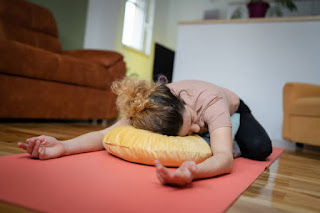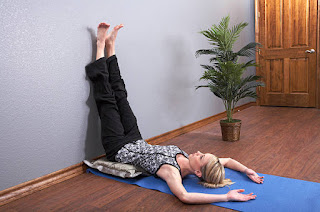Midlife Mindfulness: Strengthening Cognitive Flexibility with Meditation
Clear Thinking, Balanced Life: How Meditation and Yoga Alleviate Brain Fog
As we navigate the complexities of midlife, many individuals find themselves balancing the demands of work, family, and personal obligations. The mental strain from juggling these responsibilities often manifests as brain fog and mental fatigue—common symptoms that can disrupt cognitive clarity and affect overall well-being. However, there is a powerful tool that can help alleviate these issues: meditation, combined with yoga.
The Midlife Cognitive Challenge
Cognitive flexibility refers to the brain’s ability to adapt to new information, switch between tasks, and maintain mental clarity in the face of challenges. For those in midlife, it’s a critical skill that can be eroded by prolonged stress, hormonal changes, and lack of mental rest. Symptoms of reduced cognitive flexibility include difficulty concentrating, forgetfulness, and a general sense of “cloudy” thinking.
Meditation and yoga, particularly when practiced together, offer effective strategies for improving cognitive function and reducing brain fog. By integrating breath awareness with mindful movement, you can enhance mental clarity, improve focus, and restore energy levels.
How Meditation Can Improve Cognitive Flexibility
Meditation is a proven method for enhancing cognitive flexibility by encouraging the mind to stay in the present moment. It reduces the “noise” of mental chatter, enabling the brain to process information more efficiently. There are several specific ways meditation directly impacts cognitive health:
- Reduces Mental Fatigue: Meditation lowers the body’s stress response by activating the parasympathetic nervous system, which helps slow down racing thoughts and lowers cortisol levels. In turn, this minimizes the mental weariness that can accumulate from constant decision-making and multitasking.
- Improves Focus and Attention: Mindfulness meditation strengthens the brain’s attention networks, helping individuals sustain focus for longer periods and reduce distractions. This heightened attention helps individuals deal with tasks and responsibilities with greater clarity and efficiency.
- Enhances Memory: Consistent meditation has been shown to improve both working and long-term memory. This is particularly useful in midlife, where memory lapses and forgetfulness can create frustration.
- Boosts Neuroplasticity: Meditation enhances neuroplasticity, the brain’s ability to form new neural connections. This is key in maintaining cognitive flexibility, as it allows the brain to adapt and reorganize in response to new challenges and information.
- Cultivates Emotional Regulation: Meditation fosters better emotional regulation, enabling individuals to manage stress and anxiety more effectively. This emotional stability supports clearer thinking and decision-making, both of which are critical for cognitive flexibility.
Breath Awareness: The Link Between Mind and Body
Breath awareness, or pranayama, is a powerful component of both meditation and yoga. It serves as a bridge between the mental and physical aspects of your practice. When you sync your breath with mindful movement, you encourage the brain and body to work in harmony, fostering a deeper state of relaxation and focus.
Benefits of Breath Awareness for Mental Clarity:
- Calms the Nervous System: Deep, intentional breathing activates the vagus nerve, which in turn calms the nervous system. This reduces the fight-or-flight response, helping to clear mental fog and create a sense of calm and clarity.
- Regulates Emotions: Breath awareness can help control emotional reactions by slowing the heart rate and lowering stress hormones. This makes it easier to approach situations with a clear mind and thoughtful responses, rather than reacting impulsively.
- Supports Mindfulness: When we focus on our breath, it serves as an anchor to the present moment, pulling us out of repetitive thought patterns that can lead to overthinking and mental fatigue.
Yoga for Cognitive Flexibility
Yoga, when practiced with an emphasis on breath synchronization, provides a physical and mental reset that can alleviate brain fog. It enhances cognitive performance by combining breath, movement, and mindfulness. Here’s how it helps:
- Improves Circulation: Movement in yoga promotes better blood flow to the brain, supplying it with oxygen and nutrients essential for cognitive function. Increased circulation can also support mental clarity and focus.
- Releases Tension: Chronic stress often leads to tension buildup in the body, particularly in the neck and shoulders. Yoga postures can help release this tension, which in turn reduces the physical stress that can cloud the mind.
- Boosts Energy Levels: Certain yoga sequences, particularly those focused on gentle backbends and heart-opening poses, can invigorate the body and mind. This boost in energy can help combat mental fatigue and restore clarity.
Breath Sycophancy: Understanding the Breath-Mind Connection
Before moving into the yoga sequence, it’s essential to understand the concept of breath sycophancy, or syncing breath with movement and intention. This practice requires conscious attention to the breath throughout the yoga routine, aligning each inhale and exhale with specific movements. This synchronization can deepen the effects of the practice, creating a meditative flow that enhances both cognitive function and physical well-being.
Enhancing Breath and Movement Synchronization in Yoga
Learning to sync breath with movement can feel challenging at first, especially for those new to yoga or breathwork. Here’s a step-by-step approach to help readers build this awareness gradually:
- Start Slow with Basic Movements: Before diving into full yoga sequences, begin with small, simple movements like raising your arms overhead on the inhale and lowering them on the exhale. Focus entirely on matching your breath to these gentle motions. Repeat this 5-10 times to create a rhythm between breath and movement.
- Visualize the Breath Flow: Imagine your breath as a wave moving through the body. As you inhale, picture the wave rising from your abdomen to your chest and shoulders, lifting your body gently. As you exhale, visualize the wave receding, drawing your body back into a resting state. This mental picture can help you naturally align breath with the rise and fall of your movements.
- Use a Verbal or Mental Cue: If you struggle to coordinate breath and movement, adding a simple verbal or mental cue can help. As you inhale, silently say “lift” or “expand,” and as you exhale, think “release” or “relax.” These cues will remind you to time your movements with your breath, creating a smoother, more mindful flow.
- Focus on the Exhale in Poses of Release: Many restorative poses involve a natural release of tension. In poses like Forward Fold or Child’s Pose, place greater attention on lengthening your exhale as you settle into the pose. This shift in focus not only deepens relaxation but also helps synchronize the breath more effortlessly with moments of physical release.
- Practice with Specific Breath Patterns: You can also train your breath awareness by incorporating breath patterns like Ujjayi breath (Ocean Breath) or box breathing into your yoga practice. These breathing techniques create structure and rhythm, making it easier to stay mindful of the breath as you move. Try practicing Ujjayi breath for a few minutes in Child’s Pose, then slowly transition into other poses while maintaining the breath technique.
Steps to Build Awareness of Breath:
- Seated Breath Awareness: Start by sitting in a comfortable position with a straight spine. Place one hand on your chest and the other on your abdomen. Close your eyes and observe your natural breathing pattern. Are you breathing shallowly or deeply? Practice shifting your breath to your abdomen, feeling your belly expand on the inhale and contract on the exhale. Continue this for 5 minutes.
- Box Breathing: Inhale for a count of four, hold for four, exhale for four, and hold again for four. Repeat this cycle for 3-5 minutes, focusing entirely on the breath. This technique helps train the brain to focus and remain calm, which can support cognitive clarity.
- Ujjayi Breath (Ocean Breath): Inhale deeply through the nose, and as you exhale, slightly constrict the back of your throat, creating a soft “ocean” sound. This breath technique is often used in yoga practice to maintain focus and regulate energy levels.
A Restorative Yoga Sequence for Mental Clarity
The following calming yoga sequence is designed to restore cognitive function by focusing on breath and mindful movement. Each pose is chosen for its ability to release tension, improve circulation, and enhance breath awareness.
1. Child’s Pose (Balasana)
- Begin in a kneeling position, sitting on your heels. Exhale as you fold forward, extending your arms in front of you, and rest your forehead on the mat.
- Focus on deep belly breathing, allowing your abdomen to press gently into your thighs as you inhale. Stay here for 5-10 breaths.
2. Cat-Cow (Marjaryasana-Bitilasana)
- Start on your hands and knees in a tabletop position. Inhale as you arch your back, lifting your head and tailbone (Cow Pose). Exhale as you round your back, tucking your chin to your chest (Cat Pose).
- Synchronize your breath with the movement, flowing between the two poses for 1-2 minutes.
3. Seated Forward Fold (Paschimottanasana)
- Sit with your legs extended in front of you. Inhale as you reach your arms overhead, lengthening your spine. Exhale as you fold forward, reaching for your feet or shins.
- Hold for 5-10 breaths, focusing on releasing tension in your back and hamstrings while maintaining deep, even breathing.
4. Legs Up the Wall (Viparita Karani)
- Sit beside a wall and gently swing your legs up, resting them against the wall while your back and head rest on the ground. Place your arms by your sides, palms facing up.
- Close your eyes and focus on slow, deep breathing. This pose helps improve circulation and calms the mind, making it an excellent way to reduce brain fog.
5. Savasana (Corpse Pose)
- Lie flat on your back with your arms at your sides and legs slightly apart. Close your eyes and relax completely, allowing your body to feel heavy.
- Focus on your breath, gently lengthening your inhales and exhales. Stay here for 5-10 minutes, allowing the benefits of the practice to fully integrate.
Conclusion
Incorporating meditation and yoga into your daily routine can significantly enhance cognitive flexibility, alleviate brain fog, and improve overall mental clarity. By syncing your breath with movement, you create a powerful practice that supports both mind and body. Whether you’re seeking to reduce stress, boost your focus, or simply clear the mental fog that often accompanies midlife, these tools can provide lasting benefits.










